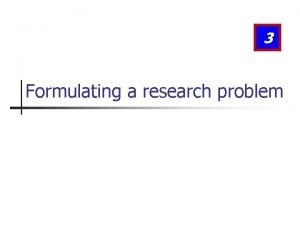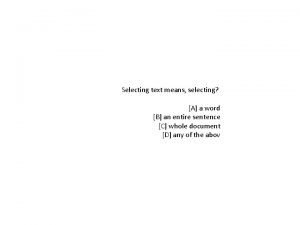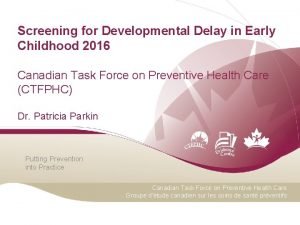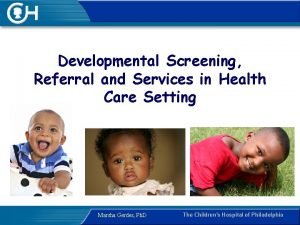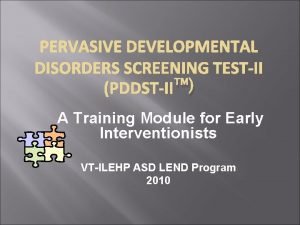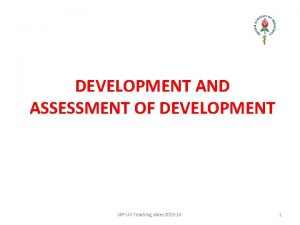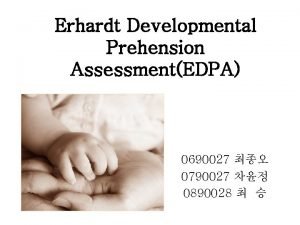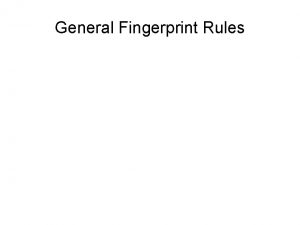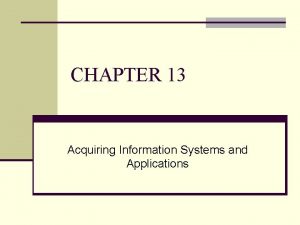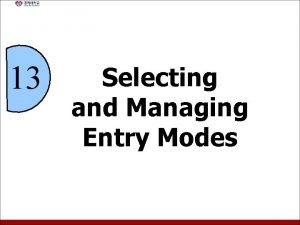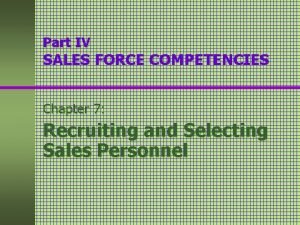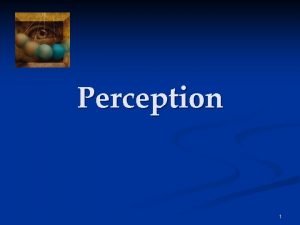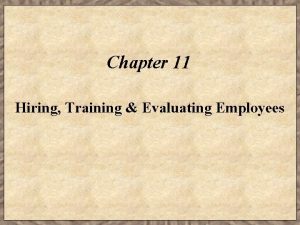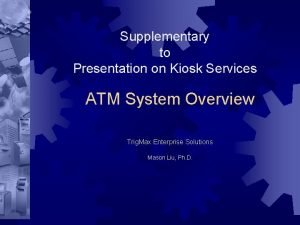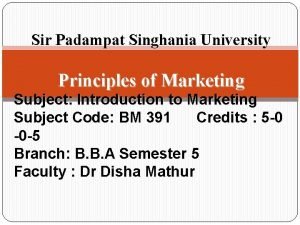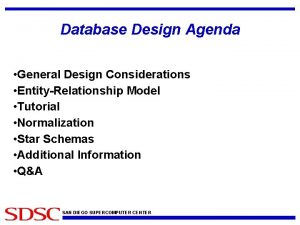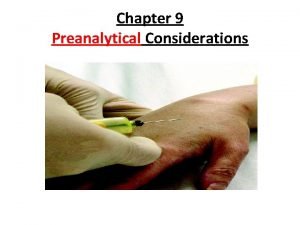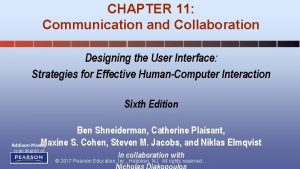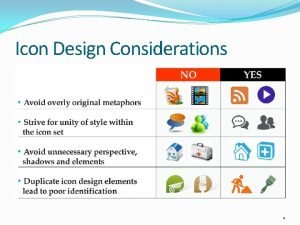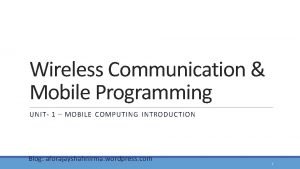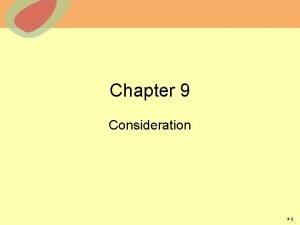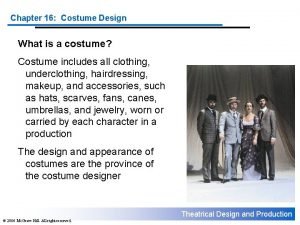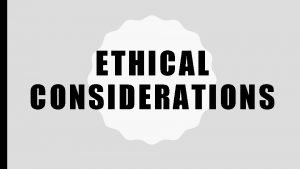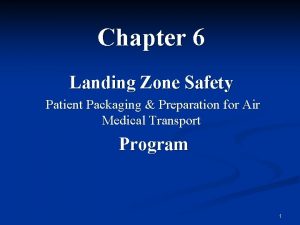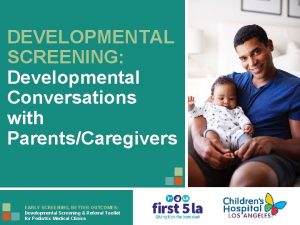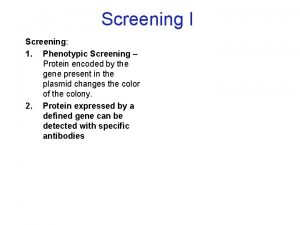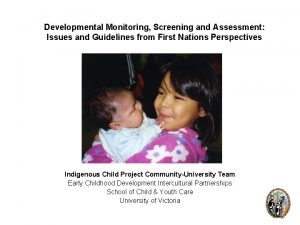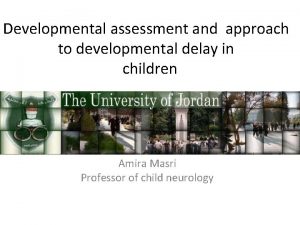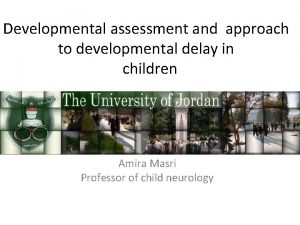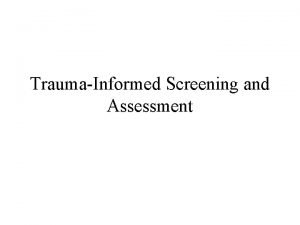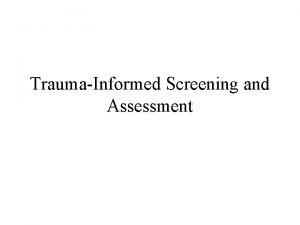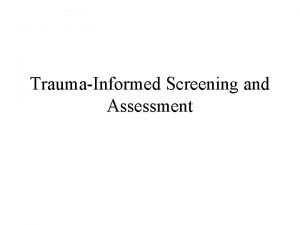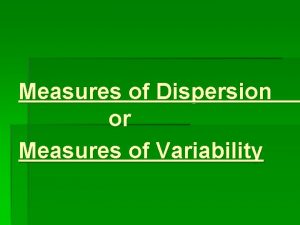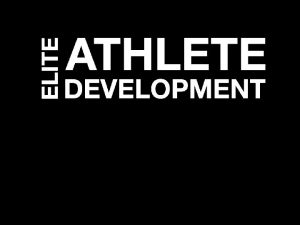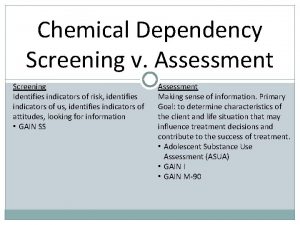Considerations in Selecting Developmental Screening and Assessment Measures























































- Slides: 55

Considerations in Selecting Developmental Screening and Assessment Measures Laurie Ford Dept. of Educational & Counselling Psychology & Special Education- UBC Mary Stewart Infant Development Program Early Childhood Education- UBC Early Childhood Assessment Conference Vancouver, BC - May 21, 2009

Objectives for the Session • Review a framework for selecting a screening and /or assessment tools • Discuss the important considerations when selecting a screening or assessment tool • Discuss common assessment terms • Discuss types of assessments • Critical evaluation of screening and assessment tools commonly used in ECE.

Getting to Know You In partners: • Introduce yourself • Where you are from and what work you do. • What is one question you want answered from this workshop. After 5 minutes: • Introduce your partner to the group and list your question.

Evaluation Who uses developmental screening tools on a regular basis? What screening or assessment tools are used?

Guidelines for screening and assessment (Miesels and Provence, 1989) 1. Screening and assessment should be viewed as services- as part of the intervention process and not only as a means of identification and measurement.

Evaluation Intervention Screening Assessment Diagnostic assessment

Guidelines for screening and assessment (Miesels and Provence, 1989) 2. Processes, procedures and instruments intended for screening and assessment should only be used for their specific purpose.

What is assessment? • Why do we do assessments with children in our programs?

Assessment Methods • Observation – Children and Adults • Informal and structured interviews – with children – with parents and child care providers • Rating scales or questionnaires • Direct Assessment


Screening Assessment Diagnostic Assessment

Screening is a brief evaluation to identify which children need further more in-depth assessment

Screening Sensitivity: Ability of the test to correctly identify children with developmental delay Specificity: Ability of the test to correctly identify children without developmental delays

Assessment is the process of obtaining information for the purposes of making evaluative decisions. To identify child and family strengths and need and to propose strategies for intervention.

Assessment Norm- referenced • Focus on comparing a child’s performance to other children (their relative development) Criterion-referenced • Identify what skills a child has and had not yet developed (compared to themselves)

Diagnostic Assessment Diagnostic approaches tend to identify whether a children have significant symptoms of certain conditions

Standardized The standard materials used in each situation. The standard method of presentation of materials in each situation

Guidelines for screening and assessment (Miesels and Provence, 1989) 3. Multiple sources of information should be included in screening and assessment

Multiple sources Screening & Assessment Tools Child Care Parents Providers

Child in Different Environments Child Family Child Care setting Child in the park community

Guidelines for screening and assessment (Miesels and Provence, 1989) 4. Developmental screening should take place on a recurrent or periodic basis. It is inappropriate to screen young children only once during their early years. Similarly, provisions should be made for reevaluation or reassessment after services have been made.


Guidelines for screening and assessment (Miesels and Provence, 1989) 5. Developmental screening should be viewed as only one path to more in-depth assessment. Failure to qualify for services based on a single source of screening information should not become a barrier to further evaluation for intervention services if other risk factors (e. g. environment, medical, familial) are present.

Guidelines for screening and assessment (Miesels and Provence, 1989) 6. Screening and assessment procedures should be reliable and valid.

Assessment • Reliability: how reliably an instrument or rater measures a variable • Validity: the degree to which a test measures what it is intends to measure

Assessment What population was this test “normed” on?

Guidelines for screening and assessment (Miesels and Provence, 1989) 7. Family members should be an integral part of the screening and assessment process. Information provided by family members is critically important for determining whether or not to initiate more in-depth assessment and for designing appropriate intervention strategies. Parents should be accorded complete informed consent at all stages of the screening and assessment process.


Guidelines for screening and assessment (Miesels and Provence, 1989) 8. During screening or assessment of developmental strengths and problems, the more relevant and familiar the tasks and setting are to the child and the child’s family, the more likely it is that the results will be valid.

Which “shoe” will child know?

Guidelines for screening and assessment (Miesels and Provence, 1989) 9. All tests, procedures and processes for screening or assessment must be culturally sensitive.


Guidelines for screening and assessment (Miesels and Provence, 1989) 10. Extensive and comprehensive training is needed by those who screen and assess very young children.



Some Common Screening Tools (ASQ) Ages & Stages Questionaire • • Parkyn Screen • Nipissing District Developemental Screen (NDDS) • Denver-II • Developmental Indicators of the Activities for Learning (DIAL-3) • Early Screening Inventory- Revised (ESI-R) • Brigance Screening

Ages & Stages Questionnaire (ASQ) • • Squires, Potter, & Bricker (1999) Publisher: Paul H. Brookes Caregiver Report is the informant Families and children between the ages of 4 and 60 months

Ages & Stages Questionnaire (ASQ) Training Administration & Scoring Requirements: Questionairres are written at a 6 th grade reading level Each questionairre takes about 15 minutes to complete Interpretation must be done by professionals or para professionals Training materials provided in Users Guide and extra video is also available No adaptation for individuals with disabilities

Ages & Stages Questionnaire. Social Emotional (ASQ-SE) Can be administered by parents, child care providers, and preschool teachers. If parents, staff should train parents Designed to compliment the ASQ by providing information on social-emotional functioning for children 3 months to 66 months

Nipissing District Developmental Screen (NDDS) 13 versions (1 month to 6 years) • • Number of items 4 to 22 • Vision, hearing, speech-language, gross motor, fine motor, cognitive, self-help • English, French, Spanish, Chinese, Vietnamese • Developed in Ontario during the mid 90 s

Early Screening Inventory. Revised (ESI-R) • Examines development in three major areas: – Visual-Motor/Adaptive – Language and Cognition – Gross Motor • Examine in each area but you also get a total score

Early Screening Inventory. Revised (ESI-R) • Brief developmental screening instrument that is individually administered to children ages 3 to 6 years. • Designed to identify children who may be in need of special services to perform successfully upon school entry • ESI-P: Preschool Version 3 yrs-4 yrs 6 mos • ESI-K: Kindergarten Version 4 yrs 5 mos -5 yrs 6 mos.

Early Screening Inventory. Revised (ESI-R) • Visual-Motor/Adaptive – Fine Motor – Eye Hand Coordination – Short term Memory • Language & Cognition – – Language comprehension Verbal Expression Reason & Count Auditory Sequences • Gross Motor

Common Developmental Assessment Tools • Cognitive - Level C – Bayley Scales of Infant Development- 2 nd Edition – Stanford-Binet Scales of Intelligence - 5 th Edition – Wecshler Preschool & Primary Scale of Intelligence 3 rd Edition – Kaufman Assessment Battery for Children - 2 nd Edition – Leiter - Revised ? Others you have seen ?

Bayley Scales of Infant Development - 2 nd Edition • Designed for children from birth to 3 years, 6 months • Includes a mental and a motor scale • The mental scale measures cognitive, sensory, and early language skills but just gives you an overall score

Common Developmental Assessment Tools • Language Tests – Peabody Picture Vocabulary Test - 4 th Ed – Expressive Vocabulary Test – Bracken Basic Concept Scale-Revised • Multiple Domain Tests – Mullen Scales of Early Learning – Battelle Developmental Inventory - 2 nd Ed

Peabody Picture Vocabulary Test - 4 th Edition • Used with a wide age range starting at 2 years, 6 months to 90+ • Best thought of as measure of receptive language. • The child has to point to the correct of 4 pictures. • Used by psychologists and speech-language pathologists

Battelle Developmental Inventory, 2 nd Edition Jean Newborg Riverside Publishing/Nelson Canada

Domains and Sub-domains of the BDI 2 Adaptive Domain Self-Care Personal Responsibility Personal. Social Domain Adult Interaction Peer Interaction Self-Concept and Social Role Communication Domain Motor Domain Receptive Gross Motor Communication Fine Motor Expressive Communication Perceptual Motor Cognitive Domain Attention and Memory Reasoning and Academic Skills Perception and Concepts

Some Common Criterion Referenced Assessment Tools • Gessell • Brigance Diagnostic Inventory of Early Development. Revised • Assessment, Evaluation, and Programming System (AEPS) • Hawaii Early Learning Profile (HELP) • Others?

Gesell Developmental Schedules • A developmental schedule used primarily with infants and very young children • Examines fine and gross motor, communication, personal-social, and adaptive behaviors in children 4 to 72 months • Developed to help describe key benchmarks. • Will provide a Developmental Quotient (DQ) but mostly reported as age-equivalents.

Brigance Diagnostic Inventory of Early Development • Direct child and parent assessment; parent observations • Birth to 7 years of age • Training: The examiner should have in depth knowledge of child development and be familiar with the manual procedures

Assessment, Evaluation, and Programming System (AEPS) Bricker, Cripe, & Slentz (1993) Paul H. Brookes

Assessment, Evaluation, and Programming System (AEPS) • Observation, direct assessment, and parent/caregiver/therapist report • Age Range (two versions): Birth to 3 years: 3 to 6 years • Designed to be used on an on going basis to monitor progress • Can be used by direct service personnel and specialists

Hawaii Early Learning Profile (HELP) • Two versions - Birth to Three and Preschool (3 to 6 years) • Areas include: cognitive (including receptive language), expressive language, fine & gross motor, self-help adaptive, and social. • Allows for adaptations for students with special needs. • Home and Center based formats
 Dissect the broad area into sub areas
Dissect the broad area into sub areas Selecting text means
Selecting text means Selection criteria for international assignments
Selection criteria for international assignments Denver developmental screening test
Denver developmental screening test Developmental screening vs surveillance
Developmental screening vs surveillance Trivandrum developmental screening chart
Trivandrum developmental screening chart Trivandrum developmental screening test
Trivandrum developmental screening test Pervasive developmental disorder screening test
Pervasive developmental disorder screening test Iap slides
Iap slides Anova repeated measures
Anova repeated measures Erhardt developmental prehension assessment
Erhardt developmental prehension assessment Writing strategies and ethical considerations
Writing strategies and ethical considerations Ethical considerations in experimental research
Ethical considerations in experimental research Pricing considerations and approaches
Pricing considerations and approaches Rules in locating the core
Rules in locating the core Potential development projects can be identified by
Potential development projects can be identified by Chapter 18 eggs selecting and storing eggs
Chapter 18 eggs selecting and storing eggs Strategies for acquiring it applications
Strategies for acquiring it applications Selecting and managing entry modes
Selecting and managing entry modes Nnn promotions interview questions
Nnn promotions interview questions Selecting organizing and interpreting information
Selecting organizing and interpreting information Specific purpose statement
Specific purpose statement Hiring training and evaluating employees
Hiring training and evaluating employees Chapter 5 selecting a topic and a purpose
Chapter 5 selecting a topic and a purpose Specific purpose statements
Specific purpose statements What are the general considerations in machine design
What are the general considerations in machine design Tax considerations for setting up a new business
Tax considerations for setting up a new business Atm kiosk software
Atm kiosk software Three considerations of societal marketing concept
Three considerations of societal marketing concept Mechanical considerations of transmission line
Mechanical considerations of transmission line Database design considerations
Database design considerations Neurological considerations in language acquisition
Neurological considerations in language acquisition Cloud delivery model
Cloud delivery model Pre-analytical considerations in phlebotomy
Pre-analytical considerations in phlebotomy Bioreactor considerations for animal cell culture
Bioreactor considerations for animal cell culture Collaboration design considerations
Collaboration design considerations Principles of tooth preparation in fpd
Principles of tooth preparation in fpd Antecubial region
Antecubial region Biopharmaceutic considerations in drug product design
Biopharmaceutic considerations in drug product design Premylohyoid area
Premylohyoid area Dogso y spa
Dogso y spa Design considerations icons
Design considerations icons Acclimatisation pdhpe
Acclimatisation pdhpe Natalya hasan
Natalya hasan Slim cd inc
Slim cd inc Design considerations for mobile computing
Design considerations for mobile computing Appendix sample
Appendix sample Non rebreather mask definition
Non rebreather mask definition Ethical considerations examples
Ethical considerations examples Examples of consideration
Examples of consideration Web security considerations
Web security considerations Practical considerations for costume design might include
Practical considerations for costume design might include Operational considerations definition
Operational considerations definition Ethical consideration in research
Ethical consideration in research Azure landing zone considerations
Azure landing zone considerations Data warehouse considerations
Data warehouse considerations
